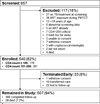Implementation and operational research: Integrated pre-antiretroviral therapy screening and treatment for tuberculosis and cryptococcal antigenemia
- PMID: 25761234
- PMCID: PMC4357272
- DOI: 10.1097/QAI.0000000000000527
Implementation and operational research: Integrated pre-antiretroviral therapy screening and treatment for tuberculosis and cryptococcal antigenemia
Abstract
Objective: To demonstrate the feasibility of integrated screening for cryptococcal antigenemia and tuberculosis (TB) before antiretroviral therapy (ART) initiation and to assess disease specific and all-cause mortality in the first 6 months of follow-up.
Methods: We enrolled a cohort of HIV-infected, ART-naive adults with CD4 counts ≤250 cells per microliter in rural Uganda who were followed for 6 months after ART initiation. All subjects underwent screening for TB; those with CD4 ≤100 cells per microliter also had cryptococcal antigen (CrAg) screening. For those who screened positive, standard treatment for TB or preemptive treatment for cryptococcal infection was initiated, followed by ART 2 weeks later.
Results: Of 540 participants enrolled, pre-ART screening detected 10.6% (57/540) with prevalent TB and 6.8% (12/177 with CD4 count ≤100 cells/μL) with positive serum CrAg. After ART initiation, 13 (2.4%) patients were diagnosed with TB and 1 patient developed cryptococcal meningitis. Overall 7.2% of participants died (incidence rate 15.6 per 100 person-years at risk). Death rates were significantly higher among subjects with TB and cryptococcal antigenemia compared with subjects without these diagnoses. In multivariate analysis, significant risk factors for mortality were male sex, baseline anemia of hemoglobin ≤10 mg/dL, wasting defined as body mass index ≤15.5 kg/m, and opportunistic infections (TB, positive serum CrAg).
Conclusions: Pre-ART screening for opportunistic infections detects many prevalent cases of TB and cryptococcal infection. However, severely immunosuppressed and symptomatic HIV patients continue to experience high mortality after ART initiation.
Conflict of interest statement
Conflicts of Interest
All authors declare no conflicts of interest.
Figures


References
-
- Global Update on HIV Treatment 2013: Results, Impact and Opportunities. Kuala Lumpur: WHO; 2013.
-
- Antiretroviral Medicines in Low-and Middle-Income Countries: Forcasts of Global and Regional Demand for 2013–2016. The World Health Organization. 2014
-
- Castelnuovo B, Manabe Y, Kiragga A, Kamya M, Easterbrook P, Kambugu A. Cause-specific mortality and the contribution of immune reconstitution inflammatory syndrome in the first 3 years after antiretroviral therapy initiation in an urban African cohort. Clin Infect Dis. 2009;49:965–972. - PubMed
Publication types
MeSH terms
Substances
Grants and funding
LinkOut - more resources
Full Text Sources
Medical
Research Materials

